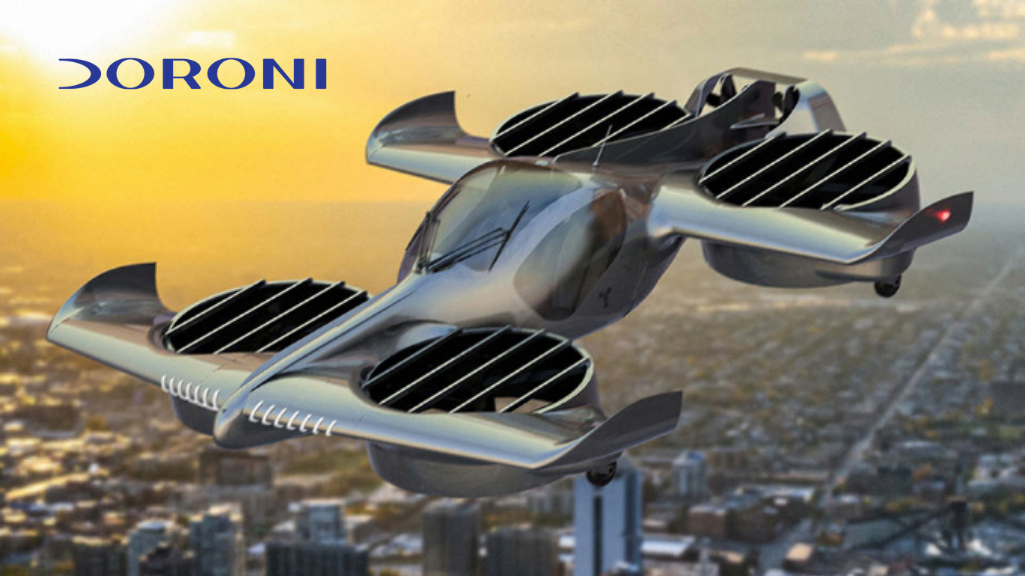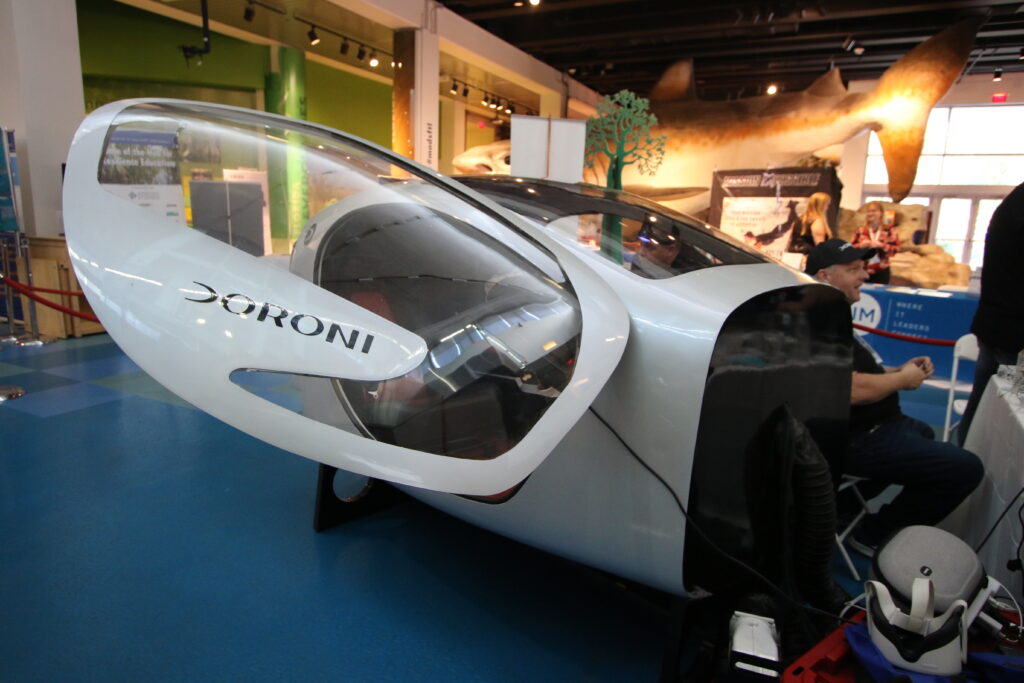 Just last week Doroni Aerospace announced the exclusive launch of their Series A Reg D funding round available to accredited investors.
Just last week Doroni Aerospace announced the exclusive launch of their Series A Reg D funding round available to accredited investors.
Morgan Stanley research predicted that the eVTOL (electric vertical taken off and landing) market will reach over $1 trillion by 2040. Doroni is on a mission to capitalize on this opportunity today and aims to make this technology accessible to everyone.
With backing and support from Space Florida, Doroni has already raised over $3.6 million from over 2000 investors and taken just under 300 pre-order requests for vehicle purchases. Just this past February, the startup completed its first untethered test flight with the Doroni H1 eVTOL. Only a handful of companies worldwide have been able to achieve this milestone.
Some of Doroni’s recent accomplishments are pretty remarkable.
- successfully completed 53 unique flight tests with the Doroni H1 P1
- built full 3D cockpit simulator tested by thousands of flight enthusiast and experienced pilots
- completed the H1 airframe with fully functional cockpit complete with software, avionics, and a computer system that’s ready for flight integration
- recruited Dan Saccani, a former Tesla and Lucid Motors CFO as our fractional CFO
- raised an impressive seed round of over $3.5M through equity crowdfunding on StartEngine.com
- working with major OEMs like Honeywell, Garmin, and Amphenol to incorporate aviation systems and components
- received an overwhelming response of 270+ preorder requests
- expanded our R&D capabilities by moving to a state-of-the-art 13,000 square foot R&D facility in Coral Springs
- received another technology patent on their latest technology in design and aerospace features from the USPTO
- garnered support from esteemed organizations such as the City of Pompano Beach, The Greater Fort Lauderdale Alliance, and Space Florida
Doroni’s mission is to bring new sustainability to commuter transportation by making flight accessible to the masses. The Doroni H1 is their go-to-market personal eVTOL (AKA “flying car”) that the company says will offer a safe, practical, and environmentally-friendly alternative to traditional automobiles. They are helping define the future of Urban Advanced Air Mobility (AAM) by engaging with the aviation industry, academia, the military, and the FAA as well as our prospective civilian and commercial customers.
On May 3rd, the Federal Aviation Administration (FAA) released an updated blueprint outlining the next steps for future future air taxi, or eVTOL aircraft, operations in the United States.
Under the blueprint developed by NASA and industry stakeholders, AAM operations will begin at a low rate with air taxis flying much as helicopters do today. They’ll use existing routes and infrastructure such as helipads and early vertiports. As the number of operations increases, air taxis are expected to fly in corridors between major airports and vertiports in city centers. The complexity of the corridors could increase over time from single one-way paths to routes serving multiple flows of aircraft flying in both directions. Over time, these corridors could link an increasing number of routes between vertiports.
The FAA expects aircraft technology will evolve as well. Aircraft automation and real-time data sharing between aircraft will likely play increasing roles in these corridors. The operational blueprint is a key step — along with certifying the aircraft and pilots — in the FAA’s effort to safely usher in and support this next era of aviation. The blueprint aims to provide a common frame of reference to the FAA, NASA and industry to help guide their research and decision-making.
Doroni is targeting a Light Sport Aircraft (LSA) certification with the FAA that would make the company extremely viable when compared to the complicated and time-consuming certification processes of larger air taxi competitors. From its inception with the Doroni Y6 and X8 prototypes that came before it, the Doroni H1 was designed to maximize safety and will undergo exhaustive multi-level quality control. As Doroni likes to say, “Safety Is In Our DNA.”

world’s first eVTOL vertiport, Air-One
What was once only seen in futuristic sci-fi movies in now becoming a reality. The world’s first eVTOL vertiport, Air-One, was opened in April 2022 in the United Kingdom. This is just one of the first of over 200 vertiport sites planned across the globe for Air-One. The vertiport was a collaboration between Urban-Air Port, a U.K.-based ground infrastructure developer, and Supernal, Hyundai Motor Group’s urban air mobility division.
According to Urban-Air Port, multiple international locations are already on the company’s order book for additional sites including efforts to bring air taxi services to Miami as soon as 2028.
The difference between Doroni and it’s competitors is its plans to offer their vehicles for personal purchase and use. The eVTOL market is divided into cargo, personal, and air taxi segments with many competitors popping up, but according to Doroni, these competitors are not focusing on personal purchase.
The personal segment is further subdivided into 1- and 2-seater categories. 1-seaters typically have an open frame with exposed propellers, have limited range, and are intended for recreational/leisure use. The Doroni H1 falls under the 2-seater + Payload category. Doroni sees a tremendous benefit and value of entering the personal segment under this category and believes that as a US-based company located in the eVTOL hub of Florida, they can become a major industry player.

Doron Merdinger
Flying an aircraft may seem like a daunting task, but Doroni’s Founder and CEO, Doron Merdinger, explains that anyone with a driver’s license and 20 hours of flight training from the company can do it. He also claims that it’s cleaner, quieter and more sustainable.
Doron explains this in a recent ABC News Miami interview by asking, “Why do we need to destroy nature in general when we introduce a system that doesn’t require roads, does not pollute, doesn’t make noise at that level?”
He continued, “I can tell you 100% that the technology for what we are doing is here now. It’s not in the future – it’s here now.”
“We will experience nature. . . It will be safer, quieter and more efficient.”
The 1650 lb. 2-seater, Doroni H1, can fly a couple hundred feet off the ground with a flying distance of 60 miles, cruising speed at 100 miles per hour, and maximum speed of 140 miles per hour. The aircraft is expected to charge from approximately 20% to 80% in just 15 – 20 minutes which is extremely fast.
The Doroni H1 aircraft cockpit was a popular exhibit at Tech Hub’s 10th annual TECHpalooza 2022. The company brought out the full size cockpit for attendees to experience the future of transportation.
Using a virtual reality headset and simple joystick (not steering wheel), attendees could imagine gliding through the sky in the Doroni H1 eVTOL aircraft. For most, this was the first flying car prototype they had ever seen or even heard of.
Flying cars could be a reality within the next 2 years. The cost is currently around $250k, but once the cost of materials levels out, the technology such as batteries becomes more accessible, the company expects the prices to lower, or at least not increase, over time.
“This is real and this is happening – We have come a long way from where we were just a decade ago,” stated Billy Nolen, FAA acting administrator.
Investors, visit the Doroni website now to learn more and secure your stake in the future of mobility: https://www.doroni.io/



